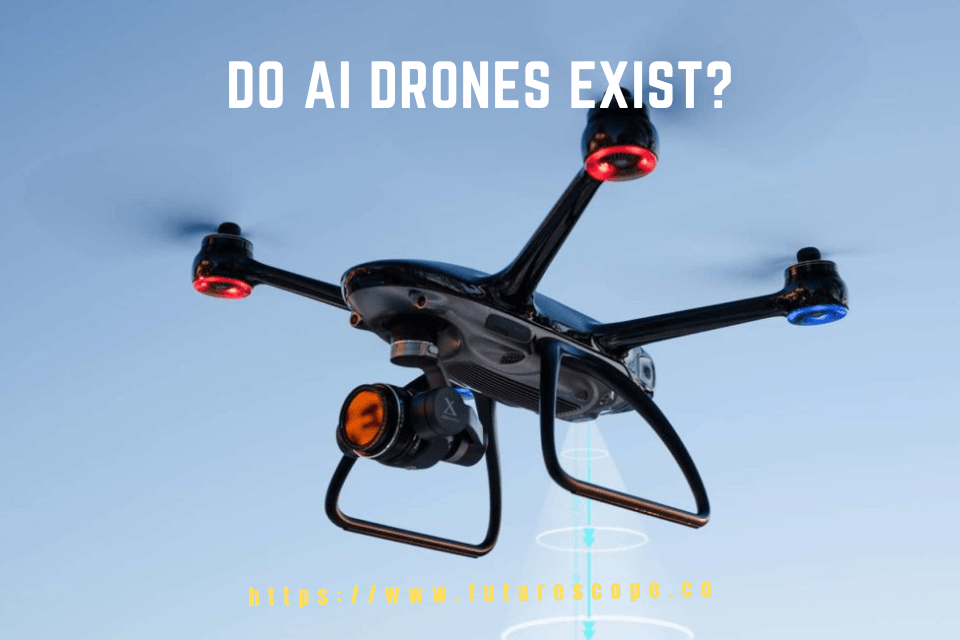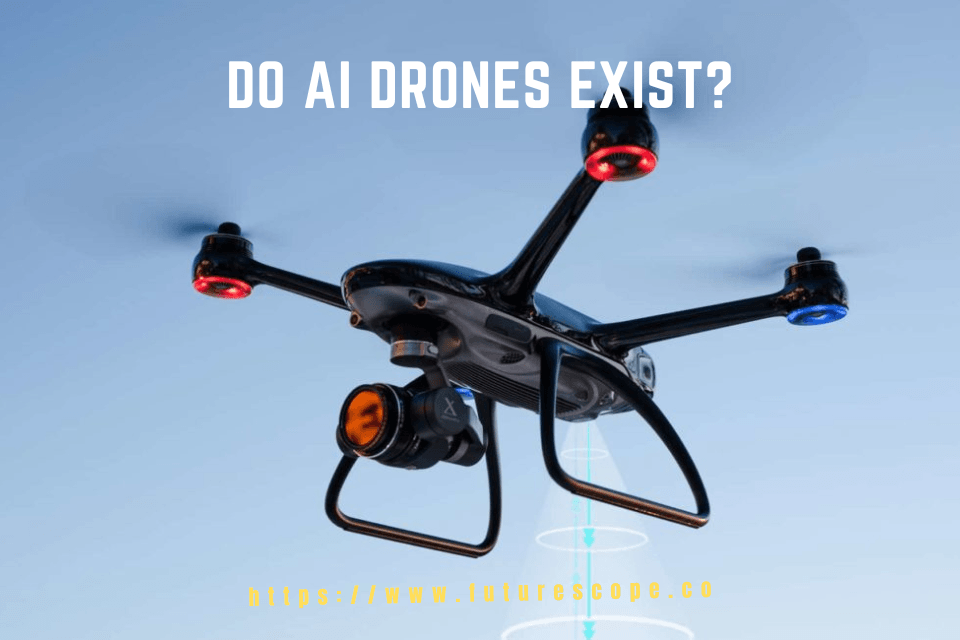What We Have Covered in This Article
Last Updated on April 30, 2023 by Editor Futurescope
AI drones are becoming increasingly popular in many industries, from military and surveillance to agriculture and delivery services. The use of AI in drones allows them to operate autonomously, without the need for human intervention, and to perform tasks that were previously impossible or too dangerous for humans. But do AI drones really exist, or are they just a concept?
The answer is yes, AI drones do exist. Many companies are developing and manufacturing drones that use AI to process data and make decisions in real-time. These drones can perform a wide range of tasks, from surveying land and inspecting infrastructure to delivering packages and providing emergency services. AI drones are also being used by the military for reconnaissance and surveillance, as well as for targeted strikes against enemy targets.
What are AI Drones?
AI drones, also known as autonomous drones, are unmanned aerial vehicles (UAVs) that use artificial intelligence (AI) to navigate and perform tasks without human intervention. These drones are equipped with sensors, cameras, and other technologies that allow them to collect data, process information, and make decisions based on that data.
Definition of AI Drones
According to Built In, AI drones are “pairing the real-time machine learning technology of AI with the exploratory abilities of unmanned drones [to give] ground-level operators a human-like eye-in-the-sky.” In other words, AI drones are drones that are able to operate autonomously, using AI algorithms to analyze data and make decisions without human intervention.
AI-enabled drones can make real-time decisions on their own, without human input. This is especially useful in situations where time is of the essence, such as search and rescue missions or disaster relief efforts. AI also allows drones to avoid obstacles and navigate through tight spaces.
Thanks largely to artificial intelligence (AI), drones are a rapidly expanding industry, with a seemingly endless list of applications. With AI, drones collect key data, adapt to what they are seeing in real time, and transmit that data to decision-makers on the ground, or can even be programmed to make those decisions themselves.
Overall, AI drones are a powerful tool that can be used in a variety of industries, from agriculture to public safety. With their ability to operate autonomously, they offer a range of benefits, including increased efficiency, improved safety, and reduced costs.
History of AI Drones
Early Development
The concept of drones, or unmanned aerial vehicles (UAVs), can be traced back to the mid-19th century when Austria attacked Venice using unmanned balloons stuffed with explosives. However, the development of AI-powered drones is a more recent phenomenon.
In the 1990s, the US military began experimenting with UAVs that were remotely controlled by human pilots. These early drones were primarily used for reconnaissance and surveillance missions. However, as technology advanced, researchers began exploring the potential of AI to enable drones to operate autonomously.
Current State of AI Drones
Today, AI-powered drones are being used in a wide range of applications, from agriculture and construction to search and rescue and public safety. These drones are equipped with sophisticated sensors and cameras that allow them to perceive their surroundings and navigate autonomously.
One of the most significant advantages of AI-powered drones is their ability to operate in environments that are too dangerous or difficult for human pilots. For example, drones equipped with thermal imaging cameras can be used to detect heat signatures in burning buildings, allowing firefighters to locate people who may be trapped inside.
In the military, AI-powered drones are being used for a range of missions, including surveillance, reconnaissance, and even combat. These drones can fly for extended periods of time, providing real-time intelligence to military commanders.
Overall, the development of AI-powered drones has opened up new possibilities for a range of industries. As technology continues to advance, it is likely that we will see even more sophisticated and capable drones in the future.
Do Military Drones Utilize AI Technology?
Military drones have become an increasingly popular tool in modern warfare. They allow for remote surveillance, reconnaissance, and even targeted attacks. However, the use of artificial intelligence (AI) in military drones has raised concerns about the potential for autonomous decision-making and the ethical implications of such technology.
AI technology has the potential to greatly enhance the capabilities of military drones. Machine learning algorithms can be used to analyze data from sensors and cameras on drones, allowing them to identify targets and make decisions based on that information. This can greatly reduce the workload of human operators and increase the speed and accuracy of drone operations. However, there are also concerns about the potential for AI to make decisions without human oversight, leading to unintended consequences and ethical dilemmas.
Despite these concerns, the use of AI in military drones is already underway. The US military has been using drones since the early 2000s and has recently begun incorporating AI technology into their operations. Other countries, including China and Russia, are also investing in AI-powered drones. As technology continues to advance, it is likely that the use of AI in military drones will become even more prevalent.
What are military drones?
Military drones, also known as unmanned aerial vehicles (UAVs), are aircraft that are remotely controlled or fly autonomously. They are used for a variety of purposes, including reconnaissance, surveillance, and attack missions. Military drones can be small enough to fit in a soldier’s backpack or large enough to carry missiles and bombs.
The use of military drones has increased significantly in recent years. They have become a critical tool for modern warfare, allowing military forces to gather intelligence, conduct surveillance, and carry out targeted strikes without putting human pilots at risk.
Military drones come in different shapes and sizes, each designed for a specific purpose. Some drones are designed for long-range surveillance and reconnaissance missions, while others are equipped with weapons for attack missions. Some drones are also designed to operate in extreme weather conditions, such as high winds and low temperatures.
Military drones are equipped with a variety of sensors and cameras, allowing them to gather data and transmit it back to the operator in real-time. They can also be equipped with advanced technologies such as artificial intelligence (AI) and machine learning algorithms to enhance their capabilities.
How do military drones work?
Military drones are unmanned aerial vehicles (UAVs) that can be remotely controlled or operate autonomously. They are designed to perform various tasks, including intelligence gathering, surveillance, and reconnaissance, as well as combat missions.
Remote Control
Most military drones are remotely controlled by human operators who are located at a ground station. The operator can control the drone’s movements, altitude, and speed using a joystick or other control devices. The drone’s camera and sensors provide real-time video and data to the operator, who can analyze the information and make decisions accordingly.
Some military drones can operate autonomously using artificial intelligence (AI) and machine learning algorithms. These drones can navigate and perform missions without human intervention. They use sensors and cameras to detect and avoid obstacles and can fly pre-programmed routes.
Autonomous drones can also use AI to analyze data in real-time and make decisions based on the information they receive. For example, a drone equipped with AI can identify and track a specific target, such as a vehicle or a person, and follow it until it reaches its destination.
Military drones can also use swarm technology, where a group of drones work together to perform a mission. Swarm drones can communicate with each other and coordinate their movements to achieve a common goal. This technology can be used to perform complex missions, such as search and rescue, or to overwhelm enemy defenses.
In conclusion, military drones can operate remotely or autonomously using AI and machine learning algorithms. They are designed to perform various tasks, including intelligence gathering, surveillance, and reconnaissance, as well as combat missions.









